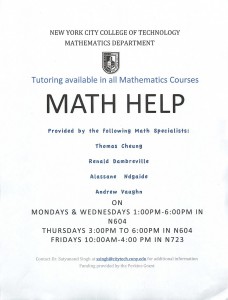Topics:
• Review of Session 8 material:
The following three things are equivalent:
- c is a root of the polynomial f(x)
- x-c is a factor of f(x)
- When you divide f(x) by x-c, the remainder is 0.
Therefore, finding roots is the same process as finding factors of a polynomial, and we have several ways to do things.
To check if x=c is a root of f(x), you can either:
* Substitute c to find f(c) and check to see if f(c) = 0
[Note: you can sometimes use the Table function in your graphing calculator to help with this, but take care in this!]
or
* Divide (preferably synthetically) by x-c to see if the remainder is 0
Usually it’s a good idea to do this, because we may want to know the quotient to find further factors or roots of f(x).
• How a double root appears in a graph and in the factorization of the polynomial.
• What goes into a complete graph of a polynomial, and looking at the output of the graphing calculator.
I am putting together a list of all the things that must appear in a complete graph, and will post it when it is done.
UPDATE: here’s the improved list:
Facts about polynomial graphs:
• The domain of a polynomial is the whole real line
• The y-intercept is the constant term
• For a polynomial of degree n, there are at most n real roots (which are the same as the x-intercepts of its graph) and there are at most n-1 local maxima or minima (turning points).
• The graph of a polynomial is continuous – no breaks or jumps
• The graph of a polynomial does not have any corners
• The graph of a non-constant polynomial does not contain any horizontal line segment
• The end behavior of the graph is determined by the leading term of the polynomial.
We saw in the examples that it is not always possible to get a complete picture of the graph using only one viewing window. Sometimes we need more than one view to get all the details.
• The Rational Roots Theorem – a way to tell whether a rational number is even a possible root of a polynomial f(x).
Basically, the theorem says that a rational number can be a root of f(x) only if its numerator is a factor of the constant term, and its denominator is a factor of the leading coefficient.
• Review of complex numbers
• The fundamental theorem of algebra and its consequences.
The important thing to remember is that the Fundamental Theorem implies that every polynomial of degree n>0 has exactly n roots, if you allow complex numbers as roots and you count each root with its multiplicity. (The multiplicity of a root is the number of times its factor appears in the factorization of f(x), in other words, it is the exponent that goes on that factor.)
Homework:
• Reread and review the definitions, vocabulary, and the examples discussed in class. Make sure that you understand the reasoning that is being used in the examples.
• Do the assigned parts of Exercises 8.3 and 8.4 (note: assigned last time!), Exercise 9.4, and do Exercise 10.2
• No WeBWorK this time.
• Do the Warm-Up for graphs of polynomials (really an “old-up”!) by Tuesday 11 PM. Start early!
• Read ahead Session 10 as time permits. It will help a lot.




